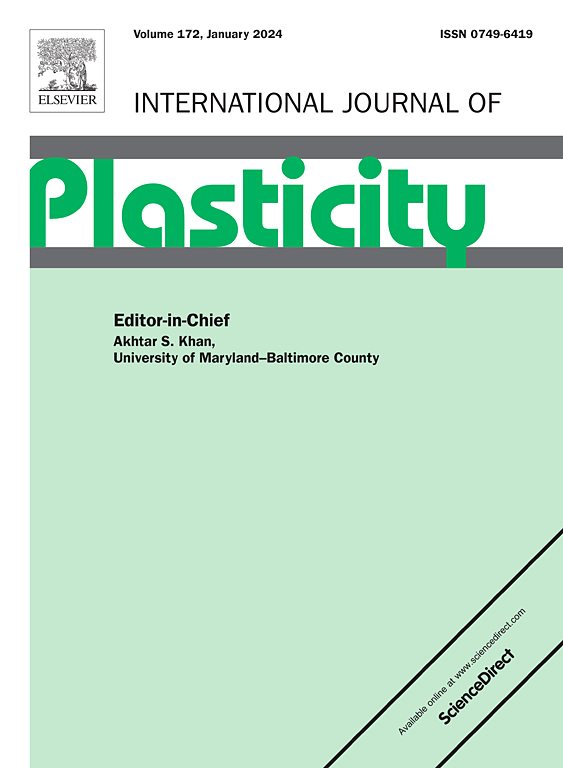Dynamic dislocation response in aluminum single crystals under multiple laser peening: A physics-based crystal plasticity study
IF 12.8
1区 材料科学
Q1 ENGINEERING, MECHANICAL
引用次数: 0
Abstract
Understanding dislocation dynamics at high strain rates is critical for analyzing the deformation behavior of metals under laser peening (LP). However, power law crystal plasticity models cannot capture the dislocation motion and evolution during high-dynamic laser shock loading. This study simulates the dislocation response of aluminum single crystals under laser peening based on a crystal plasticity finite element (CPFE) model incorporating thermal activation and phonon drag. After calibrating the unknown parameters with the experimental data from the split Hopkinson pressure bar (SHPB) and plate impact tests, we simulate the dynamic deformation behaviors in aluminum single crystals subjected to single and multiple laser shocks. The results indicate that dislocation patterns are axisymmetric during laser irradiation, as the dislocation velocities are close to limits, decreasing the differences among slip systems. The dislocation patterns become anisotropic during pressure relaxation as dislocations slip along the most susceptible direction. Moreover, phonon drag introduces additional slip resistance during the first laser shock, while peak resolved shear stress decreases in multiple laser shocks. The primary reason is that a higher mobile dislocation density can reduce the average dislocation velocity. Furthermore, the increment in dislocation density increases in the triple laser shocks because dislocation evolution is dominated by multiplication, the rate of which is proportional to the initial dislocation density. Additionally, the low-symmetry structure can cause a higher multiplication rate, introducing a higher dislocation density in 〈111〉-oriented single crystals than in 〈001〉 and 〈011〉. This investigation implies that the initial dislocation density and lattice orientation play crucial roles in the high dynamic deformation and microstructure evolution under LP.
多次激光强化铝单晶的动态位错响应:基于物理的晶体塑性研究
了解高应变速率下的位错动力学是分析激光强化金属变形行为的关键。然而,幂律晶体塑性模型不能反映高动态激光冲击加载过程中位错的运动和演化。基于考虑热活化和声子阻力的晶体塑性有限元模型,模拟了激光强化作用下铝单晶的位错响应。利用分离式霍普金森压杆(SHPB)和平板冲击实验数据对未知参数进行校正,模拟了单次和多次激光冲击下铝单晶的动态变形行为。结果表明,在激光辐照过程中,位错模式是轴对称的,位错速度接近极限,减小了滑移体系之间的差异。当位错沿着最易受影响的方向滑动时,位错模式在压力松弛过程中变得各向异性。此外,声子阻力在第一次激光冲击时引入了额外的滑移阻力,而在多次激光冲击时,峰值分解剪切应力降低。其主要原因是较高的可移动位错密度会降低平均位错速度。此外,在三次激光冲击中,位错密度的增量增加,因为位错的演化以乘法为主,其速率与初始位错密度成正比。此外,低对称结构可以导致更高的倍增率,在<;111>;取向单晶中引入比<;001>;和& lt; 011祝辞。研究结果表明,初始位错密度和晶格取向对LP下的高动态变形和微观组织演化起着至关重要的作用。
本文章由计算机程序翻译,如有差异,请以英文原文为准。
求助全文
约1分钟内获得全文
求助全文
来源期刊

International Journal of Plasticity
工程技术-材料科学:综合
CiteScore
15.30
自引率
26.50%
发文量
256
审稿时长
46 days
期刊介绍:
International Journal of Plasticity aims to present original research encompassing all facets of plastic deformation, damage, and fracture behavior in both isotropic and anisotropic solids. This includes exploring the thermodynamics of plasticity and fracture, continuum theory, and macroscopic as well as microscopic phenomena.
Topics of interest span the plastic behavior of single crystals and polycrystalline metals, ceramics, rocks, soils, composites, nanocrystalline and microelectronics materials, shape memory alloys, ferroelectric ceramics, thin films, and polymers. Additionally, the journal covers plasticity aspects of failure and fracture mechanics. Contributions involving significant experimental, numerical, or theoretical advancements that enhance the understanding of the plastic behavior of solids are particularly valued. Papers addressing the modeling of finite nonlinear elastic deformation, bearing similarities to the modeling of plastic deformation, are also welcomed.
 求助内容:
求助内容: 应助结果提醒方式:
应助结果提醒方式:


